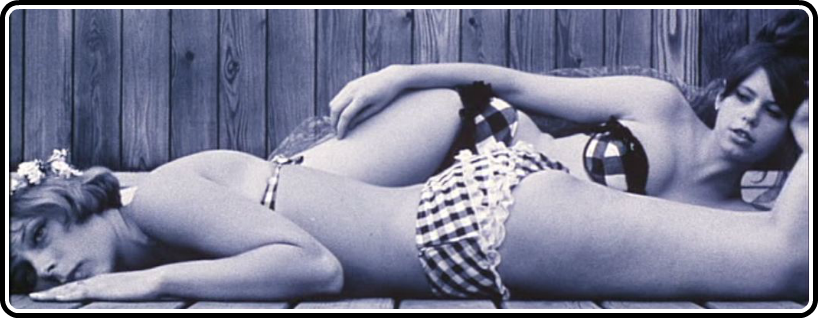
For my latest step on this journey through the Eclipse Series, I find myself in an unusual situation. Most of the time (other than when I’m reviewing a new release set), my effort here is to serve as that proverbial lone voice in the wilderness looking to shed some light and draw some attention to obscure films that aren’t currently generating much buzz. But this week, things are a lot different, in that the title I chose was (unbeknownst to me) right on the verge of a major p.r. campaign on its behalf (well, major by art house standards anyway.) Through the coordinated strategies of Criterion, Janus Films and other key players who all have a stake in its revival tour, Daisies, part of Eclipse Series 32: Pearls of the Czech New Wave, has garnered the attention of major media outlets like the New York Times, the Wall Street Journal and the Village Voice. Their film reviewers, as well as a host of other specialized cinema and news publications, have all recently given a high profile to this frenetic underground classic, thanks to a new 35mm print that’s touring around the country and playing in New York City this weekend. Besides the publicity for the film itself, Criterion is pulling out all the stops, with Current articles featuring Daisies cut-out paper dolls and a spiffy photo gallery that accompanied the box set’s release back in April.
So I have to ask myself, am I feeling up to snuff to step into the cultural-critical ring with those heavyweights? Or am I content to let them hold court and lay down their authoritative takes on this amazing, unique expression of mid-60s Eastern bloc feminist surrealism without offering my own in-depth analysis of what Vera Chytilova and her collaborators concocted in that special time and place? As it turns out, time pressures and my desire to get this post online ASAP are pressing me to just rattle off my thoughts without thinking it through as much as I usually try to. I have a vacation to pack for and other important things to do, so my approach to this splendid film is to just load up the post with some of my favorite screencaps, allow them to mostly speak for themselves, and sincerely urge you, if you find them at all intriguing or pleasant to gaze upon, to GO SEE THIS FILM – even if the best that you can do is to find a copy of the DVD, should the theatrical print be too long in arriving in your vicinity.

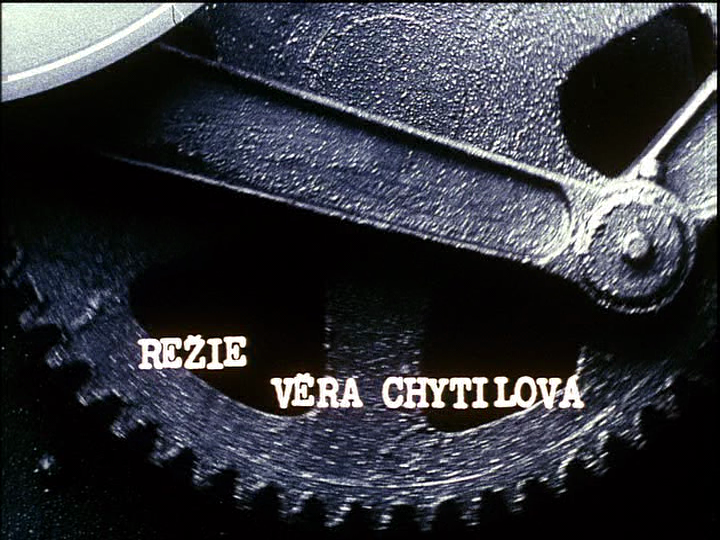
So if you want to learn about Vera Chytilova, who she was and how she staked out her place as the only female director of the Czech New Wave (an audacious achievement on her behalf, given all the pressures she had to overcome to not simply accept a more subordinate role in the government-controlled film industry) you can check out this link. As for a summary of the plot, what Daisies is actually about, there’s not a whole lot to say. Basically, two girls just coming into young adulthood take a quick, disdainful appraisal of the world around them, see how messed up it is, and decide that it’s within their rights to just let themselves be spoiled too. Fueled by the excitement and sense of endless possibilities that this freedom to just go rotten suddenly allows them, the girls (named Maria I, the brunette, and Maria II, the blonde) utilize the resources most obviously at their disposal – namely, their irrepressible cuteness and manic imaginations – to wreak havoc all around them in an ever-so-charming way. Is there a lesson or moral of the story to be gleaned from the string of pranks and chaotic destruction that ensues? I guess it all depends. To the censors, Ms. Chytilova and her defenders asserted that Daisies shows the consequences of an undisciplined, shallow, self-indulgent life. That tidy summary might have carried a bit more gravitas if the girls didn’t appear to be having so much fun cutting loose, most often at the expense of respectable and prestigious male authority figures.
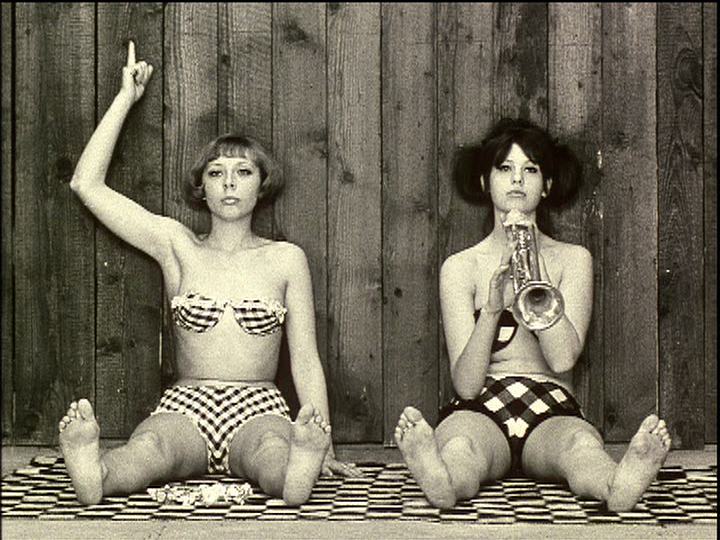
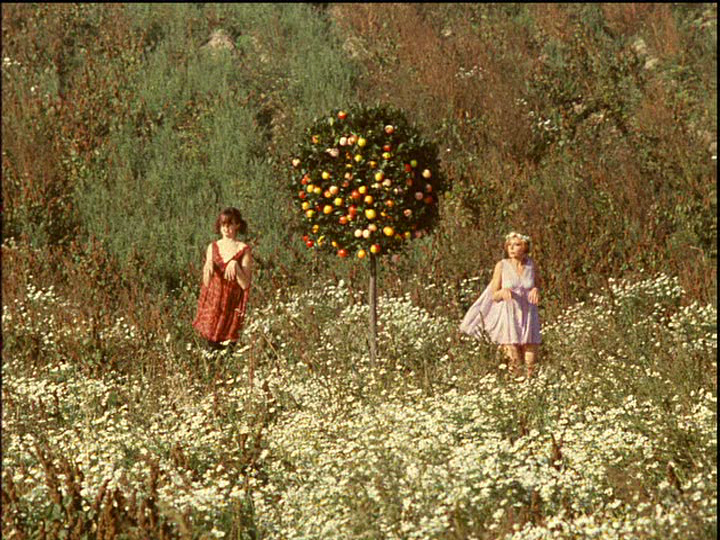
So as it turns out, the censors mostly had the upper hand in severely limiting the exposure of Daisies, effectively clamping the film down for a couple years after it was first released in 1966. The Prague Spring of 1968 created enough of an opening for Daisies to blossom through the cracks in the Iron Curtain, where it was seen and felt by enough people to ensure that the seeds would survive to sprout again in the future after a Soviet-led reassertion of control once again relegated the film to the list of seldom-seen contraband over the next couple of decades or so. We can certainly be grateful that this magnificent specimen of flower was preserved, and though exceedingly rare, never quite went extinct.
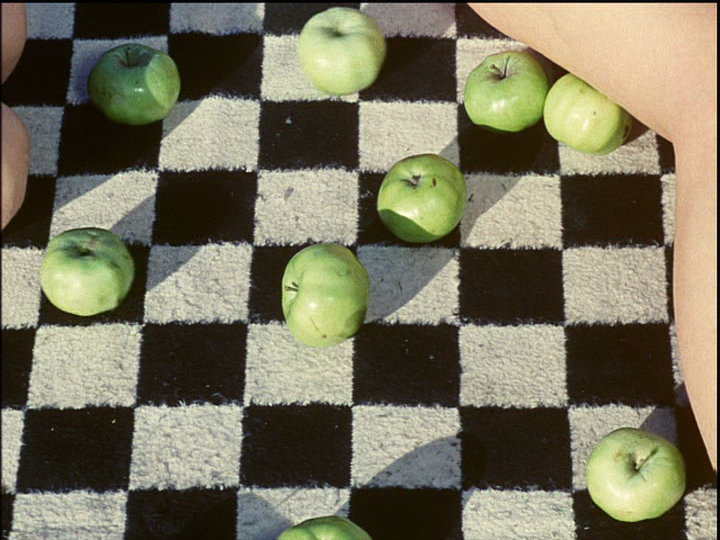
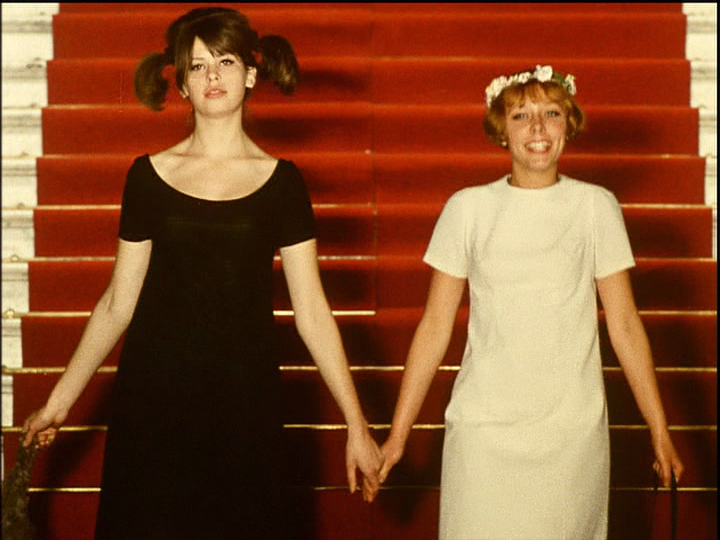
Aside from it’s inclusion in the Czech New Wave set, Daisies also stands comfortably alongside similarly zany, dadaist comic spectacles like Zazie dans le Metro, the early works of fellow Eastern European auteur Dusan Makavejev and films found in a more recent Eclipse Series release, Up All Night with Robert Downey Jr. There are even some noticeable influences of avant garde filmmakers like Stan Brakhage in some of the rapid edit montages of cut out flowers and other collage work, and randomly applied color filters that fairly scream “just because we can!” as their raison d’etre. Though it’s quite brief (a mere 76 minutes long), there’s so much creativity packed in, and such a rich abundance of visual humor and subversive counter-cultural intelligence running through it all that one could easily schedule twice the time allotted to watch the film once through in order to hit the replay button and take it in again in a single back-to-back sitting. It’s that entertaining, at least in my experience. Amateur leads Jitka Cerhova and Ivana Karbonova don’t necessarily show a lot of acting chops, but that’s no detriment at all. Their inherent playfulness and enthusiasm for the roles they signed on to play spills out with a contagious zeal to simply revel in the glorious mess they’re privileged to create.
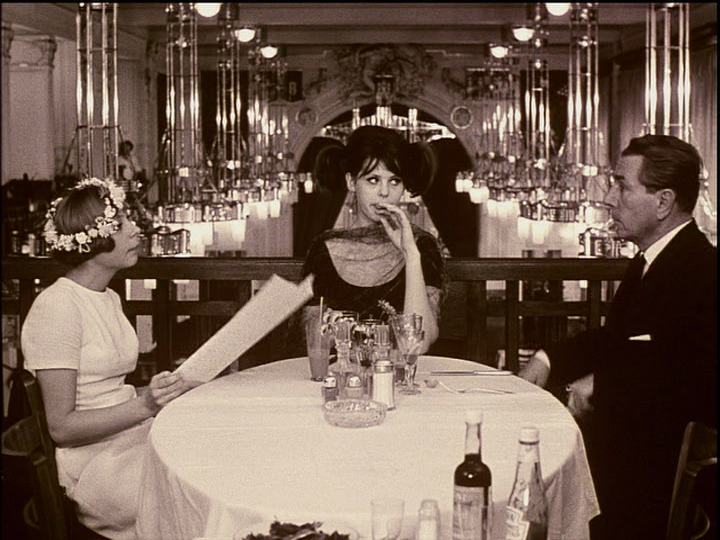
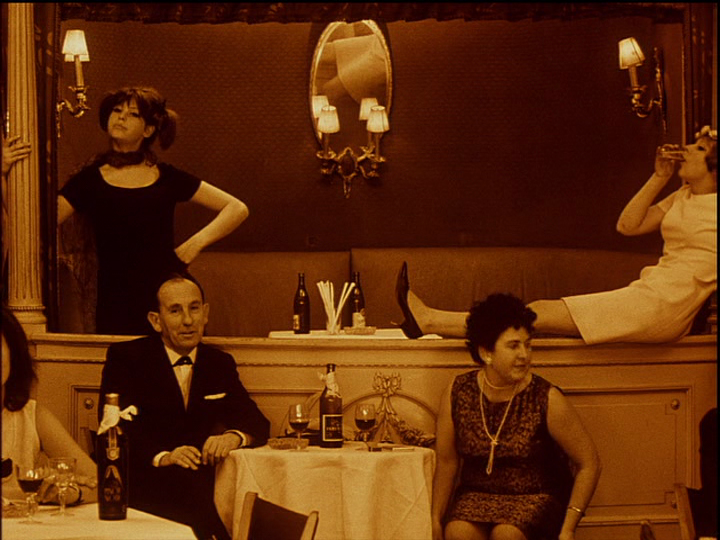
But before I declare my unabashed fondness for the girls, I have to pause for a quick reality check, since I’m at the same age and stage of life as the well-dressed fellows that they lured into a series of prankish mock-dates, in which they catered to the egos of past-their-prime suitors, merrily stringing them along until the farce played itself out and the time came to send them packing back to their wives and bourgeois comforts on the next available train. For the men, it’s a depressing reminder of their sapping vitality; for the young women, it’s an elementary exercise in seductive empowerment as we see them effortlessly toy with the men’s feelings and desires, pushing them to the breaking point as they hold out hope that their patient flattery of the pretty young things will eventually yield more immediately gratifying results – only to realize belatedly that they never even had a chance.

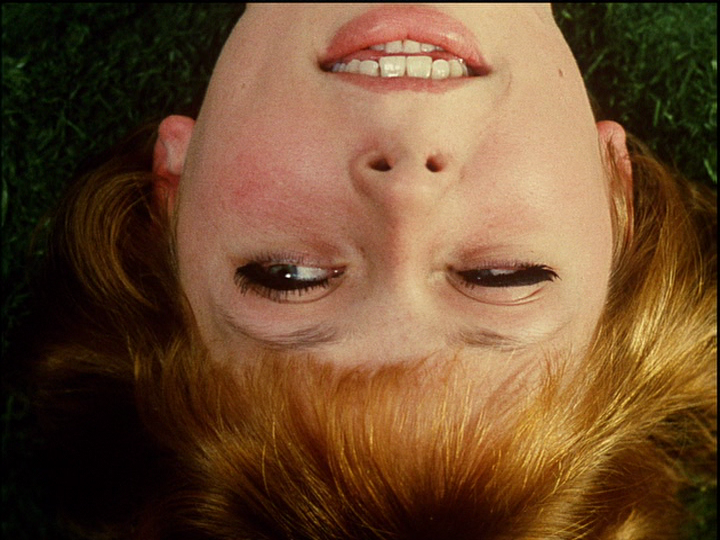
Marie I and II periodically retreat to the privacy of their flat, where they dream up future escapades in a rapid-fire torrent of mischievous rebellion without a cause. When they’re together, Marie I seems to take on more of a leader role, setting the tone for whatever stunt they may be working on out in public, with Marie II more often than not pushing back in order to assert her own perspectives in a slightly more passive aggressive manner.

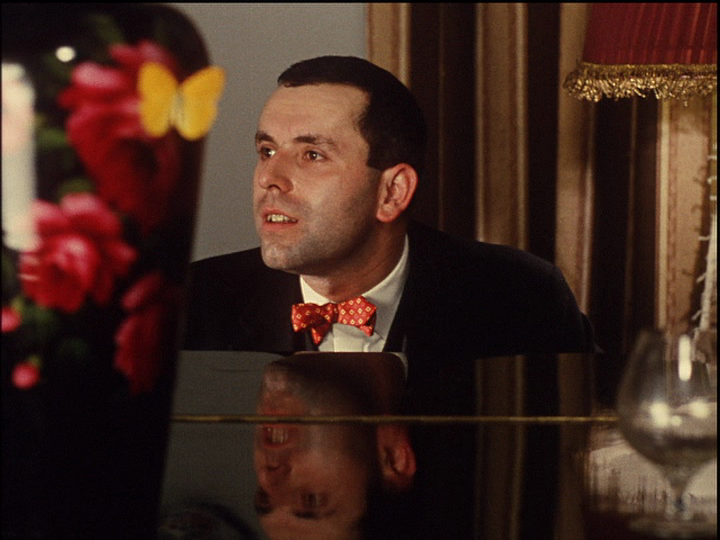
But left to exert her charms as a solo act, Marie II turns out to be quite nimble and fearless. She adopts the name “Julie” and snares a naive young songwriter, whose descent into something he considers love is disarmingly rapid and accurate, at least for those of us who have fallen under similar spells from time to time in our lives.
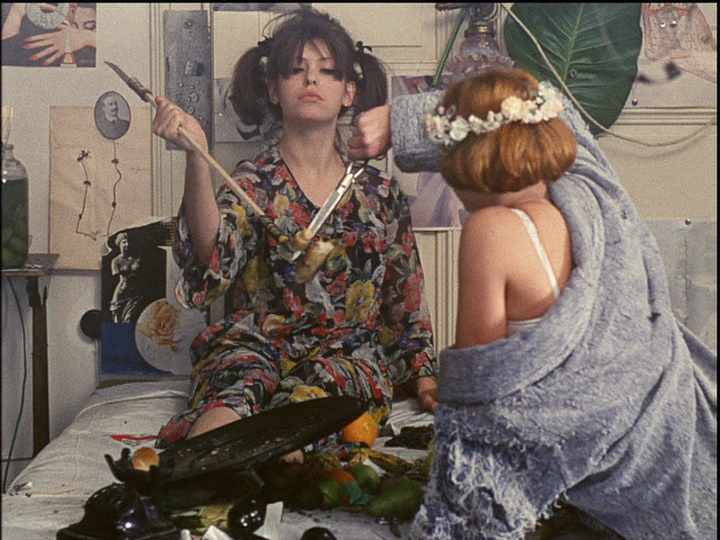
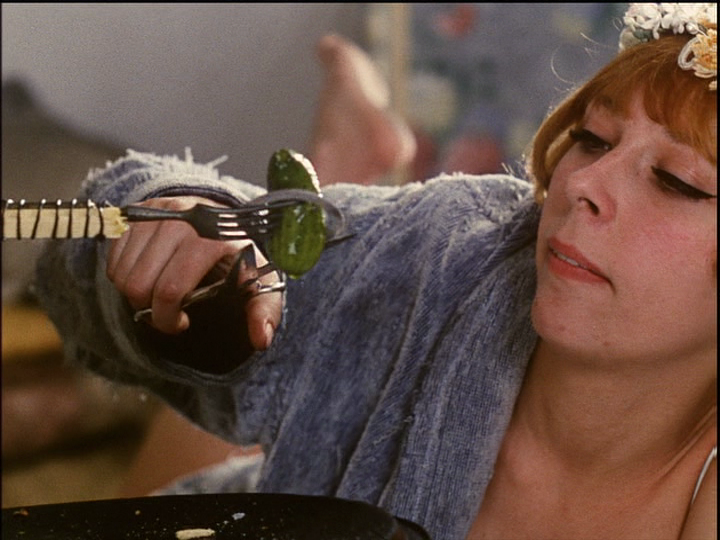
So what are the Maries up to anyway? What’s their game? We can never really tell with any great precision, simply because the women are presented as true blank slates, without any past, family encumbrances or sense of having a life beyond the narrow confines of their apartment and the various social interactions we observe. As for motivations, they seem to be mainly driven by appetite, but what exactly they’re craving is again never clearly explained. Despite some pretty blatant but incessantly whimsical emasculating imagery involving pickles, sausages, bananas and such, man-hating “revenge” seems too crude, too crass, even though they do express a general contempt for the roles and presumptions imposed upon them by their society. Or if there is some kind of payback motive at work here, their adorable playfulness just masks it all so well. When I stop to think about it a bit, it’s hard to completely shake the feeling that maybe I’m getting strung along here myself. But oh so willingly, as it turns out.

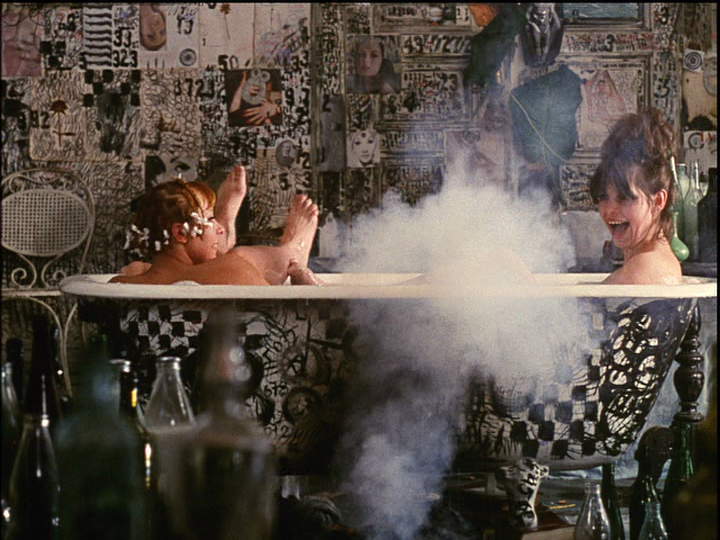
I also think it’s only fair for me to point out that my comments here are just the result of a quick surface reading, which may give the impression that Daisies is simply an indulgence in manic whimsy and bright colors, empllying attractive free-spirited young women to render the whole thing that much more fetching. The eye candy aesthetics and unrestrained slapstick are definitely here in abundance, but there’s more that’s being said by and about the women that I could draw out with further viewing and reflection. If Daisies were nothing more than mere raunch and titillation, it might have been censored but probably would have just as quickly been forgotten. The sexiness of the production is conveyed more by attitude than in graphic images, and it’s pretty clear that what really troubled the Czechoslovakian authorities was the ambiguous complexity of Daisies‘ message more than any overtly anti-government message. The Marias, and by extension director Chytilova, were simply genies that the centralized authorities did not want to let out of the bottle.
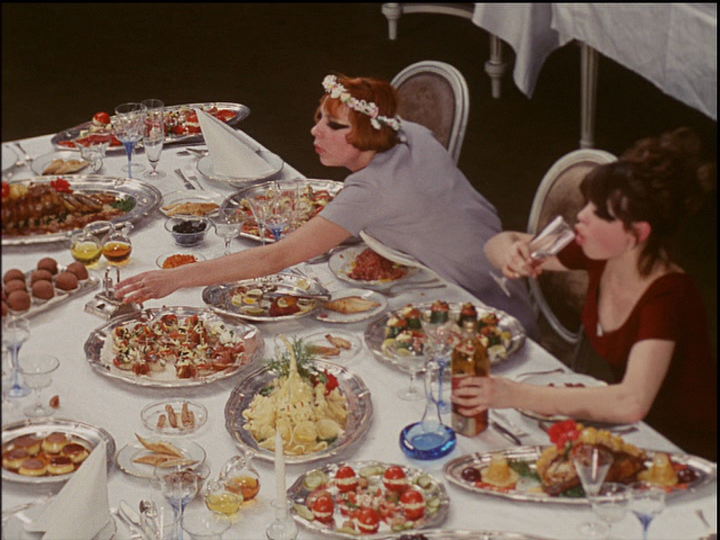
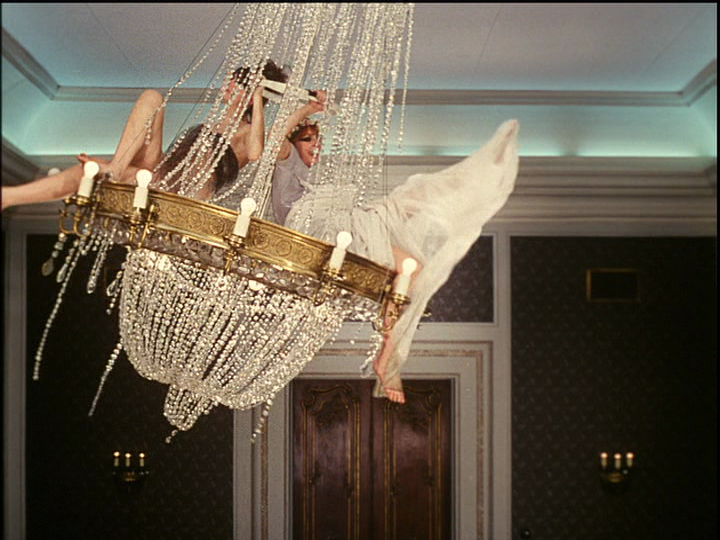
In the finest Three Stooges and Marx Brothers tradition, Daisies winds up in an epic food fight, though the stuffed shirts and pompous prigs are nowhere near the scene of the fracas. Instead, it’s Maria vs. Maria as they sneak into a lavishly decked out banquet hall well ahead of whatever guests were intended to be served, and make a complete shambles of the place, much to our delight. The spiral of madness reaches a peak that Chytilova cannot even attempt to rein in without introducing a deus ex machina resolution every bit in keeping with the absurdity that drove us to that point to begin with. The last few minutes of Daisies do represent a legitimate attempt to tie a bow around the chaos, with a lucid editorial point about the human tolerance for war, suffering and mass-killing even as we’re so easily driven to righteous indignation when social customs or rules of decorum are violated.
The drumbeat among fans of Daisies who’d like to see the film issued as a stand-alone blu-ray package has created some interesting speculation as to whether or not this will be the first Eclipse title to make the jump from that sideline label into the Criterion Collection itself. Given that a newly restored print is just now making the rounds, I suppose that makes for a tantalizing possibility, and I for one would enjoy the chance to see this visually captivating film in the highest possible resolution. The clip I embedded above gives just a small preview of Chytilova’s startling techniques. But while I can see the potential value and benefits of a more lavish presentation of Daisies, I also recognize its essential role in this set. Given the fascinating depth of the companion films in the Pearls of the Czech New Wave box, plucking this daisy from the bunch would have diminished the whole project. Chytilova’s ability to work freely did suffer as a result of the censorship she had to endure after she completed Daisies, and as fun as it is to admire in isolation, it’s more important to see how it bloomed in the context of a creative movement of its era.



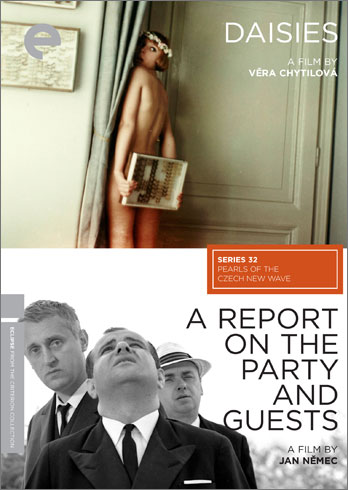

![Bergman Island (The Criterion Collection) [Blu-ray]](https://criterioncast.com/wp-content/uploads/2022/11/bergman-island-the-criterion-collection-blu-ray-400x496.jpg)
![This Is Not a Burial, It’s a Resurrection (The Criterion Collection) [Blu-ray]](https://criterioncast.com/wp-content/uploads/2022/11/this-is-not-a-burial-its-a-resurrection-the-criterion-collection-blu-ray-400x496.jpg)
![Lars von Trier's Europe Trilogy (The Criterion Collection) [The Element of Crime/Epidemic/Europa] [Blu-ray]](https://criterioncast.com/wp-content/uploads/2022/11/lars-von-triers-europe-trilogy-the-criterion-collection-the-element-of-400x496.jpg)
![Imitation of Life (The Criterion Collection) [Blu-ray]](https://criterioncast.com/wp-content/uploads/2022/11/imitation-of-life-the-criterion-collection-blu-ray-400x496.jpg)
![The Adventures of Baron Munchausen (The Criterion Collection) [4K UHD]](https://criterioncast.com/wp-content/uploads/2022/11/the-adventures-of-baron-munchausen-the-criterion-collection-4k-uhd-400x496.jpg)
![Cooley High [Criterion Collection] [Blu-ray] [1975]](https://criterioncast.com/wp-content/uploads/2022/11/cooley-high-criterion-collection-blu-ray-1975-400x496.jpg)
I love this film, and dream of a Blu-Ray edition. In the meantime I hope that 35mm print comes my way.
I just want to point out though that Věra Chytilová wasn’t the only female director of the Czech New Wave. There was Drahomíra Vihanová, who later became known for short documentaries, but she made one feature film during the era titled Squandered Sunday, and one of the co-writers of Daisies, Ester Krumbachová, herself a very prominent creative figure in the movement, directed one comedy film, Killing of the Devil, before the tanks rolled.